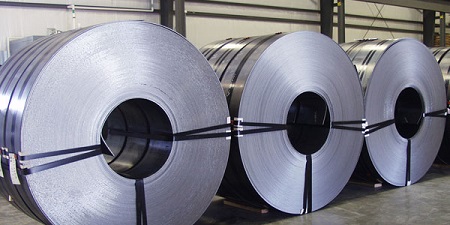Advantages Of Galvanneal Steel
The Facts
Galvannealed steel (standard galvanized) is coated with a Zinc-Iron Alloy by a process known in the metallurgical technology, as the Hot-Dip Process. This process consists of passing cold reduced sheet steel in coil form continuously through a pot of molten zinc. As the steel leaves the pot, the amount of coating allowed to remain on the sheet is controlled by coating rolls, which are used to establish minimum coating weights in accordance to ASTM Designation A525/A525M. The zinc coating is what protects the steel against corrosion. This protection acts in two ways. The zinc acts as a shield between the base steel and the atmosphere and when the base steel is exposed, such as at sheared or blanked edges, the zinc acts as a galvanic protector, sacrificing itself in the presence of corrosive elements. The coating structure consists of a layer of zinc superimposed on a thin alloy layer consisting of both iron and zinc. The solidification of the zinc layer results from crystallization of the bath metal.
Galvannealed products are increasingly in demand. They are found in a wide variety of applications requiring long-term maintenance-free corrosion protection, such as, bridges, pulp and paper mills, recreation centers, utility industries, oil refineries and petrochemical industries, automotive industry, and for miscellaneous highway uses, such as guard rails, lights, signs and fencing. Why in so many applications? Because standard galvanized products offer the most economical corrosion protection for steel.
Why you should specify Galvannealed Steel over Cold-Rolled Steel (CRS):
- Purchasing cost of sheet metal is competitive.
- Reduced preparation and painting costs.
- Provides considerably longer life-expectancy.
- Delivers excellent resistance to corrosive elements.
- Offers superb paint adhesion characteristics.
- Requires minimal maintenance.
 Galvanneal Steel is designed to combine strength, paintability and resistance to corrosion by using zinc coating as a rust inhibitor. The main property of zinc is its very slow oxidation rate which causes it to act as a long-lasting protective barrier against atmospheric corrosion as long as it remains on the steel core. During manufacturing, the galvanizing process is completed when the excess zinc has been removed from the core leaving a zinc-alloy surface, spangle-free, gray in color, and after proper cleaning it’s well suited for finish painting (and eliminates the need for prime painting).
Galvanneal Steel is designed to combine strength, paintability and resistance to corrosion by using zinc coating as a rust inhibitor. The main property of zinc is its very slow oxidation rate which causes it to act as a long-lasting protective barrier against atmospheric corrosion as long as it remains on the steel core. During manufacturing, the galvanizing process is completed when the excess zinc has been removed from the core leaving a zinc-alloy surface, spangle-free, gray in color, and after proper cleaning it’s well suited for finish painting (and eliminates the need for prime painting).
MDI® standard stock steel doors, frames and components are fabricated with commercial quality A40 Galvannealed (Satincoat) Steel with a minimum zinc coating of .40oz/sq ft. Heavier coating of A60 .60oz/sq ft and 1.25oz/sq ft, known as G90 Galvanized steel are also available for extreme atmospheric conditions.
By offering superior resistance to corrosion and eliminating the need for prime painting, Galvanneal Steel reduces costs associated with special preparations, handling and maintenance of inferior materials such as Cold Rolled Steel, thus allowing us to offer a better product at a competitive price. Even when primed and finish painted, Cold Rolled Steel is more susceptible to rust and corrosion from the inside-out, because a door is not prime-painted on the inside, leaving the bare CRS exposed to moisture.
Galvanneal Steel doors and frames are now specified world-wide for an ever expanding range of architectural projects. Government, military, educational, institutional and commercial entities in the United States, are increasingly demanding the higher quality offered by Galvanneal Steel.
For more information on the the application of various types of steel please contact our customer service department at: 516.294.1801 or use our Contact Us page to get in-touch with us.

